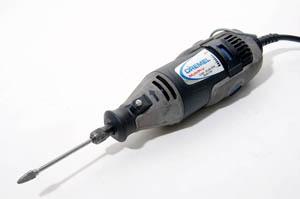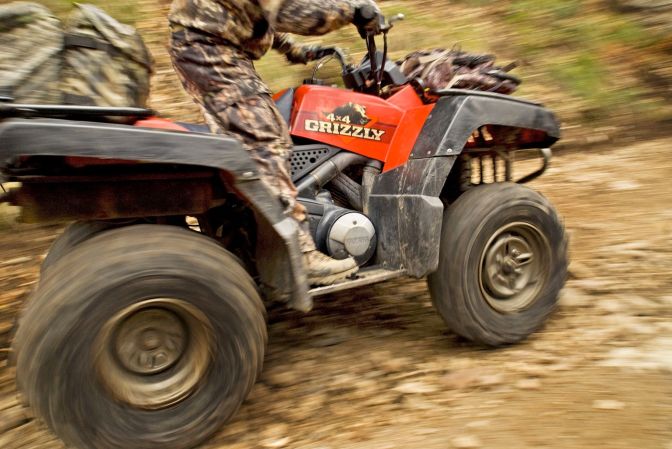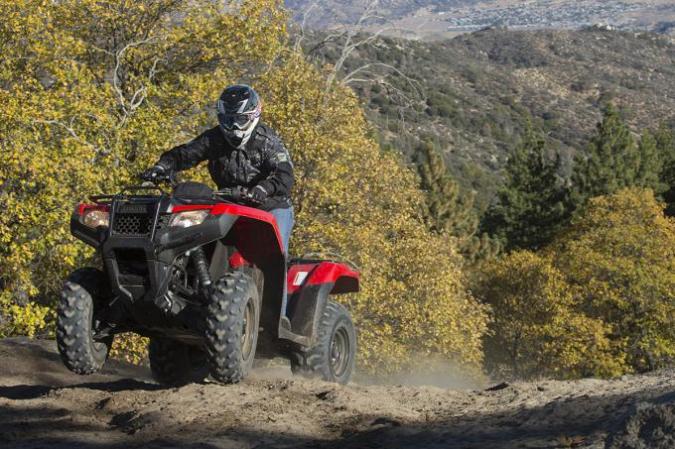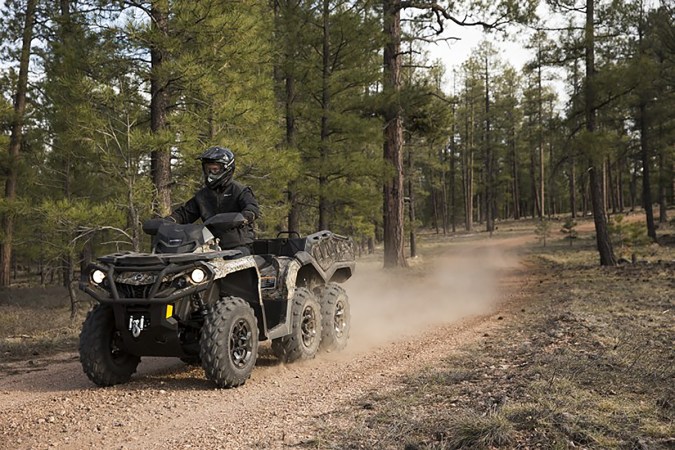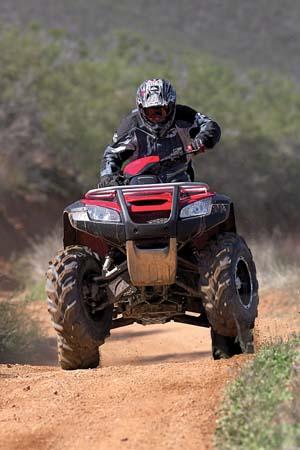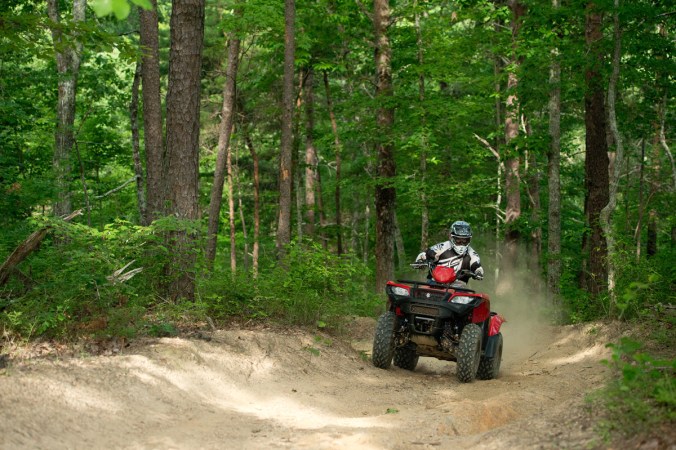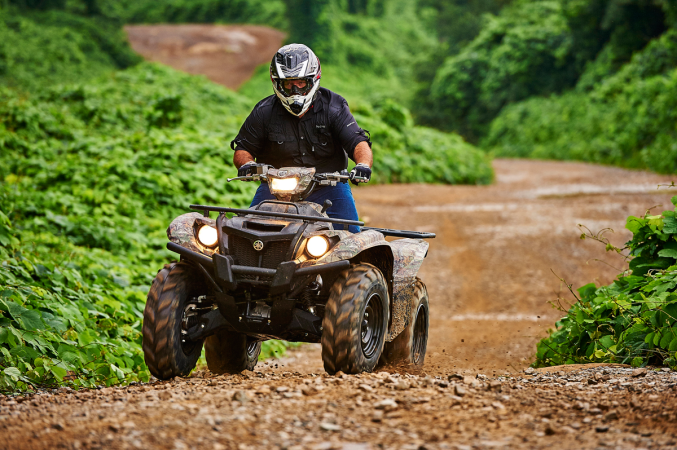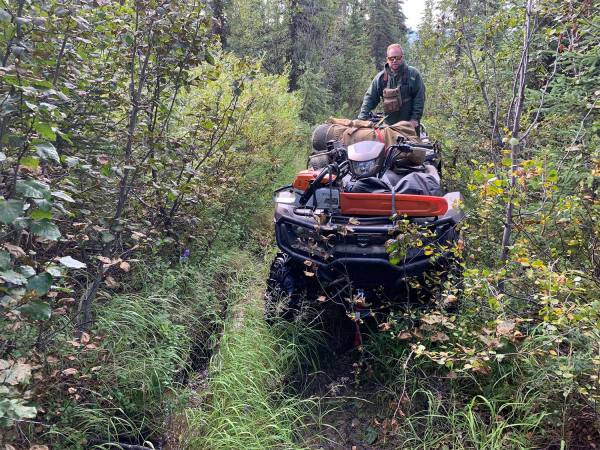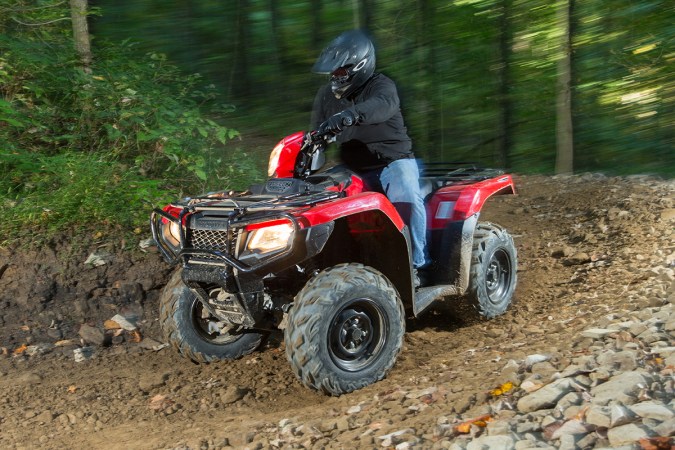We may earn revenue from the products available on this page and participate in affiliate programs. Learn More ›
Swingarm Bearing Swap
Changing swingarm pivot bearings on some swingarms is a piece of cake–you can just push them through using a socket, a vice, and a larger socket. Some bearings break up and need to come back out the way they were pressed in. This is common when the cross tube is solid (goes all the way across the front of the arm). You can try using a large punch or shaft to tap it out, but if it’s frozen or rusted in place, take a Dremel tool and split the bearing by grinding across the face of the shield of the bearing with a cutoff wheel or a grinding bit. Then it should fall right out.
Leaky Valves
This is a simple way to see if the valves are sealing on your quad’s four-stroke head. Take the head off the engine (with the valves assembled), hold the head sideways and fill the intake port with water or solvent. If you see any water leaking past the valves, you have a problem that needs to be dealt with by a professional mechanic. Then flip it over and try the exhaust side.
Free Tie Rods
For those of you who regularly align your quad’s front end, here’s a simple trick that will make your life much easier. Put “Never Seize compound on the threads of your tie-rod ends. The “Never Seize compound helps prevent the rod and rod end from getting locked up tight and it makes it much easier to realign the front end in the future.
Silicone Just Can’t Hang
Don’t put silicone sealant on your four-stroke pipes to seal them. Silicone can’t handle the heat a four-stroke pipe produces and it will break down quickly and all you’ll have is a leaky exhaust. Most four-stroke pipes will expand properly and bind together after they have been run for a while. Once the header and rear exhaust binds, it will stop leaking.
Lube It Up
Professional mechanics use assembly lube when putting together an engine, and you should do the same. We talked with the guys at CT Racing–they use a lube called Entech that can be found in many NASCAR shops, and you can probably persuade them to sell you a four-ounce bottle that will do a ton of motors. There are many other manufacturers that make something similar–Torco has a lube, as does Klotz. The key is get some and use it liberally; don’t just put lube on a new cam; use it on all of the moving parts that are wear items when assembling the engine or top end.
Run It Then Clean It
If you pressure wash your quad, it is best to start it up and ride it around to get everything up to running temperature first. This helps cut down on the buildup of condensation and moisture that may cause problems in the future. On two-strokes, it’s a good idea to remove the ignition cover after pressure washing to make sure no water has been blown in. We’ve seen lots of ruined flywheels and stators that have been turned into orange balls of rust from pressure washing and then leaving it.
Quick Clip Fix
Keihin PWK carbs are prone to breaking the needle C-clips. This can be devastating if you’re on a long ride! Buy a spare and tape it somewhere on your quad in case of an emergency. We know you’re actually not going to bother to do it, but we just wanted to be able to say, “I told you so!
Locked-Up Clutch
Most performance quads are now coming with quick-change clutch covers. This makes it easy to do the following emergency clutch repair if you’re out on the trail or endurance racing and you smoke your clutch. First, flip the quad on its side and pop the cover off. Slightly bend some of your metal plates and then bolt it back together. The clutch won’t work, but it will be locked up so you can ride it back in, and this sure beats a long tow or a night of unprepared camping.
Play It Safe
We always like to play it safe, so here’s a tip that you y not have thought of. Many off-road race organizations such as SCORE International ask for your blood type and if you have medical allergies, and then put the information on a sticker and place it on the back of your helmet. Even if you’re not racing, this is a good idea. In case of an accident, your information will be ready for rescue personnel and may save your life! If you have no known medical allergies, post that on the back of your helmet, as well. Also, put an emergency contact phone number on there…just in case.
FAQ
Q: I have a 2004 Honda TRX450R. I have noticed lately that it is getting harder to start–I’ve even had to bump start it. Once I get it going, it runs fine. I’ve tried jetting and cleaning the carburetor, but it hasn’t improved the starting. Any ideas?
A: There’s a lot of wouldas, couldas, and shouldas that can be calculated into this question, but you didn’t give us any idea of how many hours are on the engine. Your filter maintenance and type of riding may have given us better clues to the crime. But if we only get one stab at it, the first thing we would do is take the head off and check the valves. Valves that have had some dust run through them tend to get a little sticky. You may pick up another clue before plucking the head–you could check the valve clearance. If they are tighter than recommended, you need to pull the head for sure.
Q: I always clean my quad off after trail riding, especially if I go riding in a lot of mud. I lightly pressure wash everything around the engine and I think I’m pretty careful, but the other day I noticed that my axle sounded like it was squeaking. Any ideas?
A: We always tell people that when you pressure wash your quad, avoid blasting any concentrated spray directly at the seals in your swingarm and axle carrier. As a matter of fact, don’t directly pressure wash any seals–all it does is blast dirt right into the seals. It sounds like your axle carrier bearings might be loaded up with impacted dirt or possibly suffering from some corrosion. Get a shop manual and disassemble everything down to the carrier, and then properly lube and grease up the bearings. When it comes time to clean it again, make sure you clean the area with low-pressure water and a scrub brush.
Q: I have a 2003 Yamaha Raptor 660 that I use for fast trail riding and high-speed ripping on fire roads. It’s a little bit tippy in the corners, so I installed wheel spacers on the front and a wider rear axle. I think that my Raptor is more tippy now–it’s certainly not what I expected. I’m a little disappointed. I don’t really want to get a lowering kit, as I do ride trails and need the ground clearance. Help!
A: The rear axle was a good investment and would help in stability if that’s all you installed. Where you hurt the handling was when you added the wheel spacers. This over-loads your suspension and actually makes your quad more tippy (unless you add stiffer suspension to compensate for the added front width). There is no problem running the back wider than the front, so just pop off the spacers. In a pinch, you would pick up some added stability if you ran the front shocks with a stiffer preload setting. If you find a bag of cash lying around, your next purchase should be a set of aftermarket shocks.
Q: I have a new 2006 Honda TRX450R with maybe 50-60 hours on it. The quad is in perfect shape, except it has become nearly impossible to start. Once I get it running it runs fine, but most of the time I have to push or pull start it. I installed a new battery, spark plug, and cleaned the carb, and it turns over or cranks fine, but just doesn’t fire.
A: Unlike your other Honda ‘R brother, you’ve done a good job of providing information that eliminates potential problems. The more information we get the better our chances of being on target. What you failed to tell us is what a lousy job you have done keeping your air filter clean. Pop your rocker cover off and check your valve clearance. We’ll bet you double or nothing on your next subscription that your valve clearance will be way too tight–maybe even zero on some valves. If it’s just a couple of thousandths too tight, you can just re-shim it. If you have zero clearance on one or more valves, you should pull the head and have a valve job done. Refer to the December ’06 issue if you need assistance on setting the valve clearance.
Tell us is what a lousy job you have done keeping your air filter clean. Pop your rocker cover off and check your valve clearance. We’ll bet you double or nothing on your next subscription that your valve clearance will be way too tight–maybe even zero on some valves. If it’s just a couple of thousandths too tight, you can just re-shim it. If you have zero clearance on one or more valves, you should pull the head and have a valve job done. Refer to the December ’06 issue if you need assistance on setting the valve clearance.
